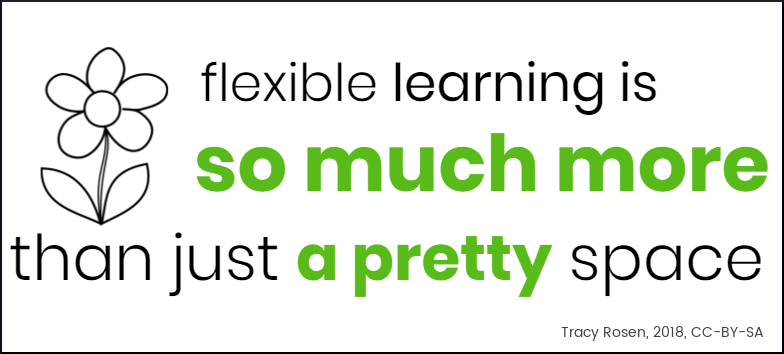More than just a pretty space

A recent edsurge article talks about how the race to buy fancy furniture is turning flexible classrooms into a fad.
What then happens is instead of designing classrooms that positively impact students, we are decorating classrooms, celebrating the new, and then moving on to the next shiny thing. Pinterest-pretty classrooms bring instant gratification, but little else.
from: How Furniture and Flexible Seating Is Turning Classroom Design Into a Fad by Robert Dillon, Jan 4, 2018, on EdSurge
And that is true.
As I like to say – flexible classrooms are so much more than just a pretty space.

If we focus on good pedagogy and design our classrooms according to that, we can stay away from jumping on a fad that will soon disappear when we ultimately discover that it isn’t a magic bullet on its own, just like any number of other education fads – remember differentiation, flipped classrooms, multiple intelligences, teaching to learning styles, technology infused learning, *insert education fad here*…
But what is good pedagogy? Even the term pedagogy is thrown around so much that its become jargon.
I think that terms like pedagogy and ideas like good teaching and learning are fluid. My belief is that good teaching and learning need to be based on theory, yet are then made very personal as they relate to each teacher’s classroom and practice.
It is no secret to those who follow my writing here or who have been to my classroom or workshops, that I define ‘good pedagogy’ as access to learning for our students. And for me, that is closely connected to how we design our learning environments.
The way I see it, it comes down to these things:
As long as we keep our goals in mind when we begin to design our learning environments we are off to a good start – and these goals need to be strongly intertwined with whatever program goals we are committed to teach
Then, if we ensure that the largest number of our students can access these goals we are off to an even better start. We can do that by providing diverse resources, diverse ways for students to see the course goals, and examples of how we can achieve these goals (processes and strategies). Actually, it is not enough to just provide them. Explicitly teaching students how to access all of this (and/or getting out of their way when they figure it out!) is an important step.
I can’t just expect success to happen. I explicitly design for it.
Build it and they will come? No. We need to change the conjunction –> Build it SO they will come.
—-
My ideas are heavily influenced by this article by CAST as well as the experiences of teachers across Quebec, some are seen here: bit.ly/qcspace and on PD Mosaic – UDL + flexible environments. A special thanks to Avi Spector, of course – we explore these ideas together a lot!
